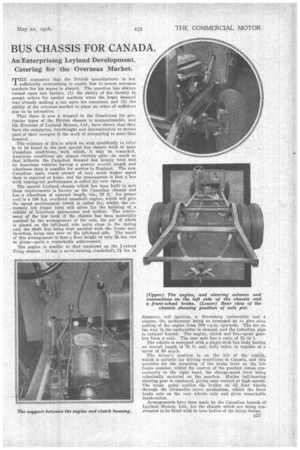BUS CHASSIS FOR CANADA.
Page 101

If you've noticed an error in this article please click here to report it so we can fix it.
An Enterprising Leyland Development. Catering for the Overseas Market
THE argument that the British manufacturer is not sufficiently enterprising to enable him to secure overseas markets for his wares is absurd. The question has always turned upon two factors, (1) the ability of his factory to accept orders for special markets when the home demand was already ma.king a tax upon his resources, and (2) the ability of the overseas market to place an order of sufficient size to be attractive.
That there is now a demand in the Dominions for particular types' of the British chassis is unquestionable, tuid the directors of Leyland Motors, Ltd., have shown that they have the enterprise, forethought and determination to devote part of their energies to the work of attempting to meet that demand.
The evidence of this to which we wish specifically to refer is to be found in the new special bus chassis built to meet Canadian conditions, with which, it may be remarked, American conditions are almost imtirely akin—so much so that hitherto the Canadian demand has largely been met by American vehicles having a greater overall length and wheelbase than is possible for service in England. The new Canadian main roads permit of very much higher speed than is required at home, and the consequence is that a bus with touring-ear performance is called for over there.
The special Leyland chassis which has been built to snit these requirements is known as the Canadian chassis and has a wheelbase of unusual length, viz., 19 ft. Its power unit is a 100 hp. overhead camshaft engine, which will give the speed performance which is called for, whilst the ex• tremely low frame level will allow for the building of a vehicle of luxurious appearance and outline. The attainment of the low level of the chassis has been materially assisted by the arrangement of the axle, the pot of which is placed on the left-band side quite close to the spring pad, the shaft line being kept parallel with the frame and, therefore, being also over on the left-hand side. The result of this arrangement is that it floor height of only 24 ins. can be given—quite a remarkable achievement.
The engine is similar to that employed on the Leylned Tittiv chassis. It has it seven-bearing crankshaft, 2i ins. in diameter, coil ignition, a Stromberg carburetter and a starter, the carburetter being so arranged as to give even pulling of the engine from 200 r.p.m. upwards. The air on the way to the carburetter is cleaned, and the induction pipe is exhaust heated. The engine, clutch and four-speed gearbox form a unit. The rear axle has a ratio of 51 to 1.
The vehicle is equipped with a single•deck bus body having an overall length of 30 ft. and, fully laden, is capable of a speed of GO m.p.h.
The driver's position is on the left of the vehicle, -which is suitable for driving conditions in Canada, and this provides for the mounting of the brake lever on the left frame member, whilst the control of the gearbox comes conveniently to the right hand, the change-speed lever being spherically mounted on the gearbox. Merles ball-bearing steering gear is employed, giving easy control at high speeds. The brake pedal applies the brakes on all four wheels through the Dewandre servo mechanism, whilst the hand brake acts on the rear wheels only and gives remarkable deceleration.
Arrangements have been made by the Canadian branch of Leyland Motors, Ltd., for the chassis which are being constructed to be fitted with de luxe bodies of the latest design.




















































































































































































































